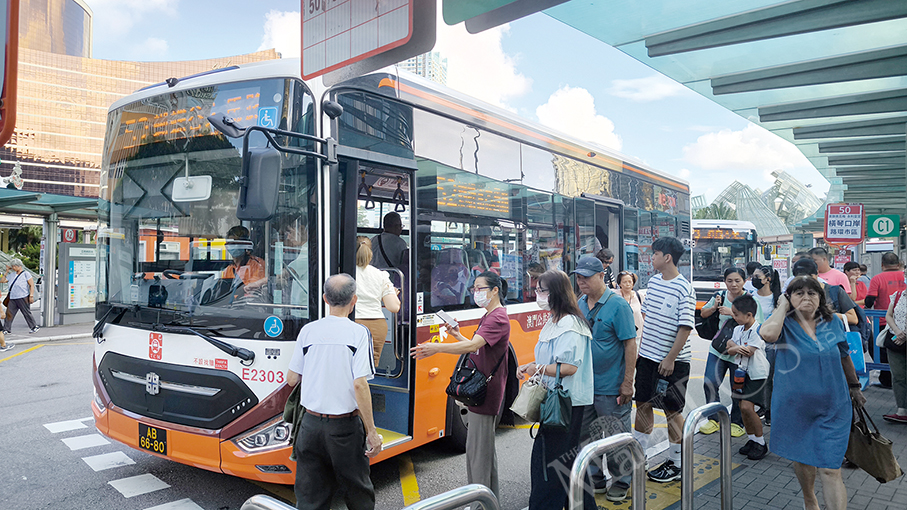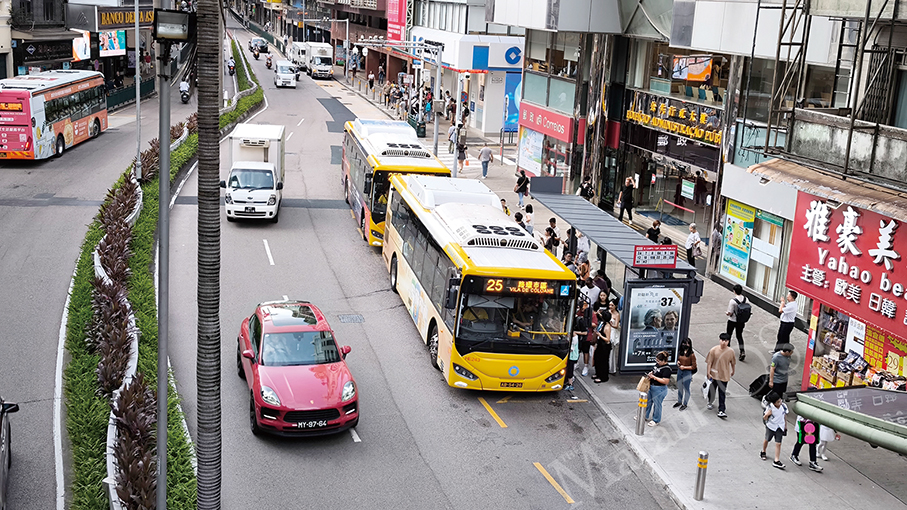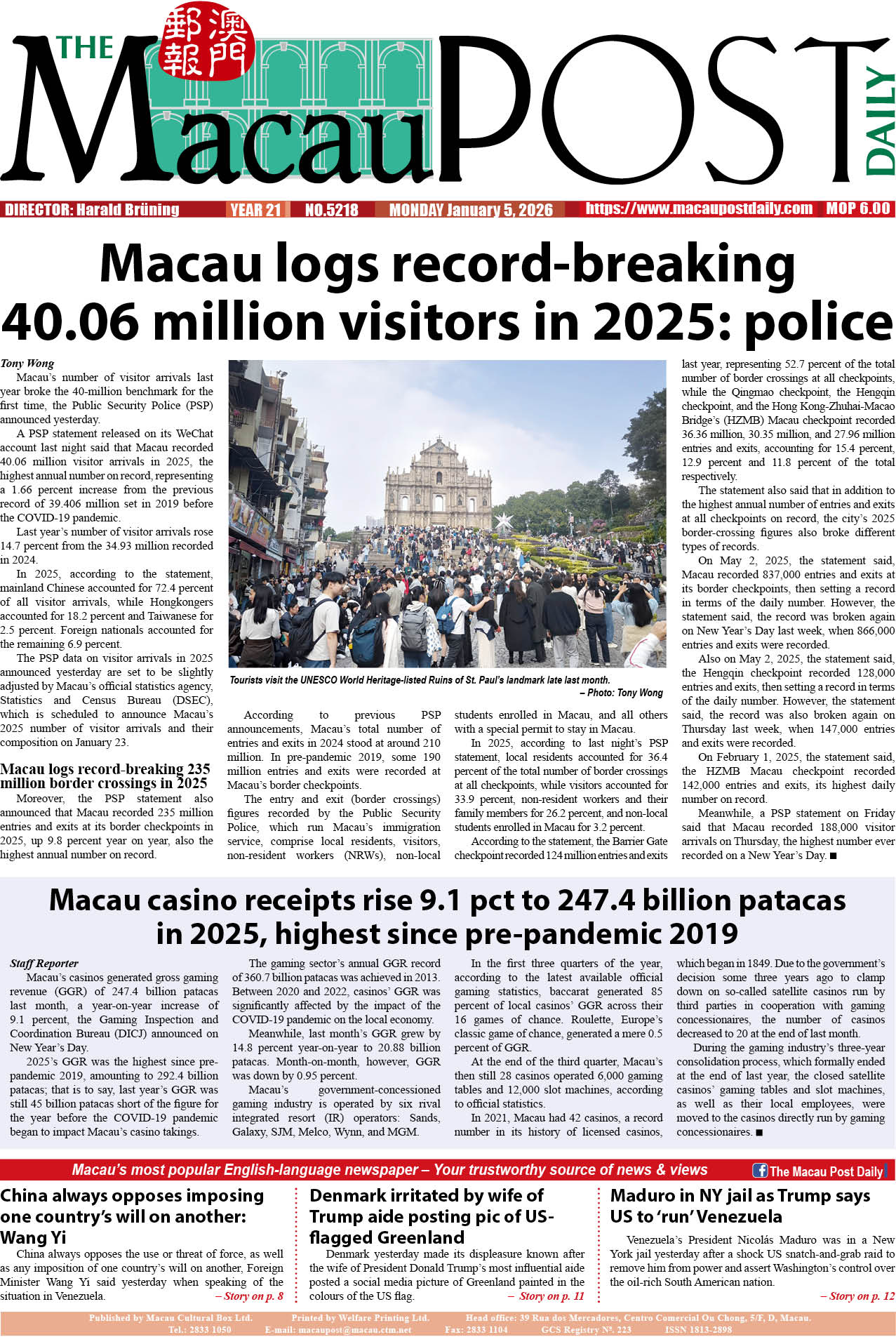Lawmaker-cum-current affairs commentator Ron Lam U Tou urges the government to carry out rigorous assessments to determine the real load capacity of the Governador Nobre de Carvalho Bridge (informally known as the “old bridge”), or release technical documents supporting the current official rule that vehicles with a gross weight of 15 tonnes or over are barred from crossing the bridge, in the wake of the fact that all public buses must be new energy vehicles (NEVs) from next month so that no large-sized buses can be used on the bridge, thereby potentially reducing the city’s sea-crossing public bus service capacity.
Lam made the remarks earlier this month in an interview with the Post at his office near Avenida de Almeida Ribeiro, the city’s main thoroughfare.
The old bridge, which opened in 1974, is one of the city’s current three sea-crossing bridges connecting the Macau peninsula and Taipa island. Many of the routes between the peninsula and Taipa run by the city’s two public bus operators use the old bridge.
According to the current regulation for the old bridge, which was promulgated in 1995 when Macau was still under temporary Portuguese administration, vehicles with a gross weight of 15 tonnes or over are barred from crossing it.
Only NEVs from next month
According to the two public bus operators’ current service agreements with the government, all of their buses must be new energy vehicles (NEVs) by August 1 this year, i.e., Thursday next week.
The two companies’ current six-year agreements, which took effect on January 1, 2021, will expire on December 31, 2026.
According to the latest available official data, at the end of the first quarter of this year the two public bus operators had a total of 1,057 buses, of which 830 were NEVs, comprising 50 natural gas buses and 780 extended-range electric buses. This means that extended-range e-buses accounted for 94 percent of the two companies’ NEVs.
Small-sized public buses are officially defined as those with a length of at least seven metres but less than nine metres, while medium-sized public buses refer to those with a length of at least nine metres but less than 10.5 metres.
Large-sized public buses are officially defined as those with a length of at least 10.5 metres but less than 13.5 metres, while mega-sized public buses refer to those with a length of at least 13.5 metres.
Why large-sized e-buses cannot cross old bridge
Due to their batteries, e-buses, including extended-range ones, are heavier than the equivalent diesel buses.
Consequently, while the two public bus operators’ large-sized diesel buses can cross the old bridge, their large-sized extended-range e-buses cannot cross it as they all exceed its 15-tonne weight limit.
Therefore, no large-sized public buses can cross the old bridge from next month, meaning that only small-sized and medium-sized buses can cross it.
Since earlier this year, the two public bus operators have been gradually replacing their large-sized diesel buses used for sea-crossing routes via the old bridge with their medium-sized extended-range e-buses.
The gross weight of a public bus is officially defined as comprising the weight of the vehicle proper plus the weight of its maximum officially allowed number of passengers.
Each of the two public bus operators’ current large-sized extended-range e-buses, i.e., the ones with three doors each, has a gross weight of 18 tonnes.
Buses crossing old bridge set to become more crowded
The Post asked Lam to comment on the matter in an interview earlier this month, where he noted that the new situation will make it more difficult for passengers to catch sea-crossing route buses, after the two public bus companies can only use medium-sized buses, which have a smaller capacity to carry passengers than their large-sized counterparts, to operate their busy sea-crossing routes using the old bridge from August 1.
Lam said that public buses with a gross weight of 15 tonnes or over are barred from crossing the old bridge “merely because of a provision listed in the 1995 regulation but the question is, technically, how did [Macau’s then government] came up with the 15-tonne weight limit?”
Lam said that, as far as he knew, the current government had never shown the public the old bridge’s original construction design, for justifying its 15-tonne weight limit.
‘Not based on scientific grounds’
“Currently, we still do not know the rationale, in terms of engineering, for the regulation’s 15-tonne weight limit,” Lam said, adding that “the government’s implementation of the weight limit seems to be merely complying with a provision, but not based on scientific grounds”.
Lam said that if the government did not have the old bridge’s original construction design, it should carry out scientific tests and assessments of the bridge in order to establish its exact maximum load capacity.
If the test results would justify the old bridge’s current 15-tonne weight limit, Lam said, then, of course, the two public bus operators’ large-sized extended-range e-buses should not be allowed to cross the old bridge because safety should always be the top priority.
Public interest
If the test results show that the old bridge’s real load capacity is higher than what its current 15-tonne weight limit for vehicles is indicating, Lam said, the weight limit should be relaxed enabling larger-sized public buses to use the old bridge.
Provided that the old bridge’s structural safety is fully ensured, Lam said, relaxing its weight limit would be in the public interest, particularly considering that the bridge has for a long time been the main link for the city’s sea-crossing public bus services.
Only public buses, taxis, emergency vehicles and other authorised vehicles are allowed to use the old bridge, a measure launched in 2005.
Revamp of circuitous bus routes
Concerning the possible scenario that the assessment results show that the old bridge’s 15-tonne weight limit must be kept intact, Lam criticised the government for not having come up with any new measures or contingency plans aiming to ensure that sea-crossing public buses will not become even more crowded, as it could be assumed that the government had been aware for a long time that no large-sized public buses can cross the old bridge from August 1 this year due to the NEV requirements.
Lam said that the predicament resulting from the August 1 NEV requirement affecting the old bridge was also highlighting the city’s long-standing fundamental problem for public bus services, one of which, he said, was the government’s failure to revamp the city’s various circuitous bus routes, which are making the city’s public bus service capacity less effective.
Lam underlined that a major revamp of the city’s bus-route network would improve its overall bus service capacity, which would help make buses on busy routes less crowded, including those crossing the old bridge.

Lawmaker Ron Lam U Tou poses during an interview with the Post at his office earlier this month. – Photos: Tony Wong

Passengers catch a No. 52 medium-sized e-bus at the Praça de Ferreira do Amaral bus terminal about three weeks ago. Previously, large-sized diesel buses were used for the route, which runs between this bus terminal and Coloane’s Seac Pai Van public housing estate.

Passengers catch a No. 25 medium-sized e-bus on Rua do Campo about two weeks ago. The route’s large-sized diesel buses have been gradually replaced with medium-sized e-buses since earlier this year. The two e-buses in this photo are 10.49 metres long each, just one centimetre shorter than the official definition of large-sized buses with a length of at least 10.5 metres. The No. 25 route run runs between the Barrier Gate checkpoint and Coloane Village.









